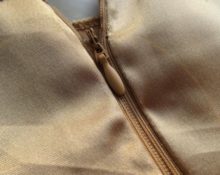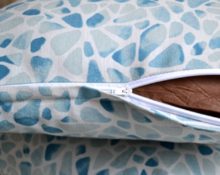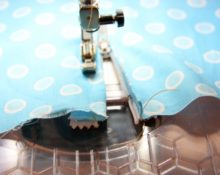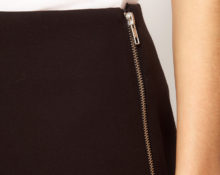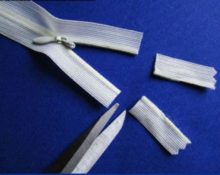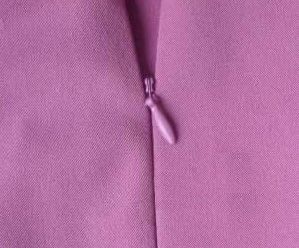 In the process of making clothes, each stage is important to obtain the proper result. The stage of sewing in a hidden zipper is no exception. This fastener is mainly used for dresses and skirts.
In the process of making clothes, each stage is important to obtain the proper result. The stage of sewing in a hidden zipper is no exception. This fastener is mainly used for dresses and skirts.
Poor quality work can greatly ruin their appearance. The wrong option puffs up or tightens the material, and also warps the fabric. To avoid such a situation, let's figure out which tool to use and how to achieve an ideal result.
We will tell you how to sew a secret lock into a skirt.
Materials and tools

First of all, you need to figure out how you will carry out the process.
- Manually. For this work you You will need safety pins, threads matching the color of the fabric, a zipper of the required size and a needle.
- Using a sewing machine. The list of required items is almost the same as with the manual method, with the exception of the tool. In this case, you will need a sewing machine.
In addition to all of the above, When inserting a zipper into thin clothing there is a risk of damage to the delicate fabric. That's why It is advisable to use cushioning material when working. Dublin is best suited for this purpose. A small strip of dublin is basted to the place where the fastener is stitched with the adhesive surface to the fabric and ironed.
Important! When sewing a skirt yourself, insert the zipper last.
What kind of sewing machine foot do you need?
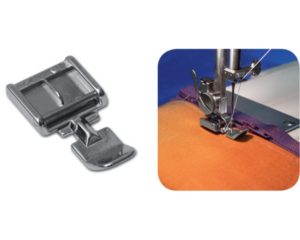
If you are an inexperienced seamstress, then when sewing a fastener mechanically, it is better for you to use a special foot.
Often, household machines are not equipped with this device, so it must be purchased separately. You should also know that depending on the manufacturer and model of your unit, this device may differ in appearance.
Sewing a hidden zipper
Sewing an invisible zipper is a little different from the usual process.
Preliminary stage
To get started, you need to finish the edges using an overlocker or bias tape.. Then, using chalk (special chalk is sold at a fabric store), mark the seam line from the inside out. This procedure must be performed on the wrong side, stepping back about one and a half centimeters from the edge. Then glue the stitching area with a strip of dublin and slightly bend the edge to the wrong side. Press the crease line, but do not iron it.
How to sew a zipper into a skirt
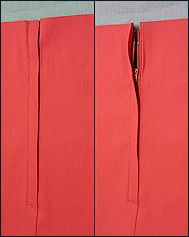
Then continue working according to the instructions given.
- Place the half of the open fastener face down on the folded edge, so that the teeth line up with the fold line.
- Align the top border of the product with the edge of the zipper.
- Carefully pin the fastener fabric to the fabric using safety pins. Wherein Place the pins across the future seam.
- Use a contrasting thread to baste the fabric and clasp.
- Further Carefully bending back the teeth, sew one side of the fastener to the skirt.
- Sew the other side in the same way.
- Close the clasp.
- Press the seams.
Attention! All seams should go from top to bottom.
How to sew a zipper into a skirt with a belt
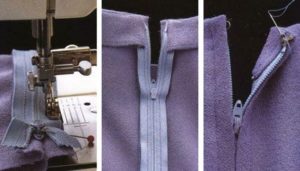
For those who want to sew a new thing with a belt, this process will be slightly different from the one already given. A few simple points are added to the above steps.
- The belt blank is folded in half, ironed and sewn on the front side.
- Carefully connect the zipper sewing points using safety pins.
- Sew on the fastener according to the instructions above.
- Sew on the second half of the belt.
How to sew a zipper on a lined skirt
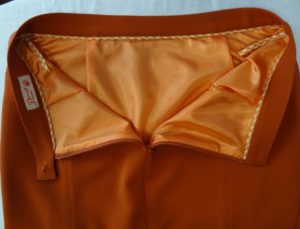
Sometimes a model requires duplicating the main fabric with a lining. And in this case, after the basic steps described, you should correctly sew the gasket as follows.
- The lining part must completely repeat the main workpiece.
- Sew the lining to the base;
- We attach the edges of the lining cut to the folded edges of the main part, on which the fastener is attached.
- Iron all seams.
In this case, all seams are located between the main fabric and the lining.
Specifics of working with a knitted skirt
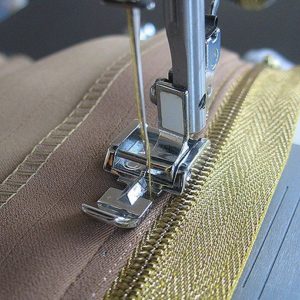
When working with knitted clothing, you need to be especially careful and careful not to spoil the item. You also need to know a few nuances that greatly facilitate the process.
- For this work purchase special needles for knitwear. They differ from regular ones in that they have a rounded tip. This shape allows you to move the thread fibers apart during sewing without compromising the appearance.
- Experiment with stitch width. For these purposes, use a small sample of knitwear.
- Necessarily glue the sewing area using dublin or non-woven fabric.
- With mechanical sewing make sure that the knitted edge does not protrude beyond the teeth.
- If you knitted the skirt yourself, you should knit a kind of pocket along the edge of the product using an English elastic band. And then, without covering the edge, sew the edges of the zipper into it.
- When working with a knitted item, the main thing is to prevent the fabric from fidgeting. That's why try to carefully secure all parts before sewing. If you don’t rush and pay enough attention to the process, you will be guaranteed an excellent final result.
Useful tips
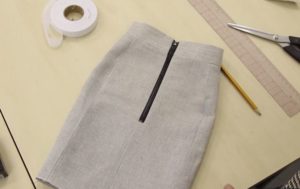
And finally, let me give you a few recommendations that will help facilitate the work process and lead to a wonderful result.
- Iron the fastener before using it. If you use a cotton ribbon as a base, then use the steam function. This needs to be done because sometimes after washing this item can stretch or, conversely, shrink. So this simple action will save you from unpleasant surprises.
- When choosing a foot for sewing on a zipper, opt for a metal model. This option will serve you longer and more efficiently than its plastic counterpart.
- Pay attention to the diameter of the needles used. Try to choose a thickness that matches the fabric being sewn. Ideally, it is better to try on a scrap piece of fabric.
- To duplicate allowances for fastening, it is better to use special interlining tapes: formband and contentband. The first option contains a central basting thread, along which it will be easier to sew a seam line.It is especially suitable for stretch fabrics or items cut on the bias. The second type is usually glued with a protrusion of one millimeter beyond the seam markings.
- If you need to trim excess length of the fastener, be sure to rearrange the limiting rivets. They will not allow the slider to come off.
- If you don't have tailor's chalk on hand, don't worry, a small piece of soap can easily replace it.
Using the above recommendations, you can sew in a hidden zipper without any problems. And you will do it correctly, even if you don’t know very much about sewing and, as they say, are a complete beginner in the sewing business.


 1
1
